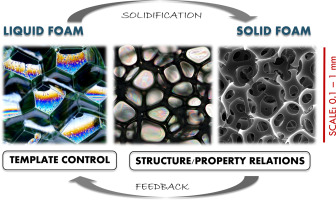Advances in Colloid and Interface Science ( IF 15.6 ) Pub Date : 2018-04-03 , DOI: 10.1016/j.cis.2018.03.010 Sébastien Andrieux , Aggeliki Quell , Cosima Stubenrauch , Wiebke Drenckhan

|
Solid foams with pore sizes between a few micrometres and a few millimetres are heavily exploited in a wide range of established and emerging applications. While the optimisation of foam applications requires a fine control over their structural properties (pore size distribution, pore opening, foam density, …), the great complexity of most foaming processes still defies a sound scientific understanding and therefore explicit control and prediction of these parameters. We therefore need to improve our understanding of existing processes and also develop new fabrication routes which we understand and which we can exploit to tailor-make new porous materials. One of these new routes is liquid templating in general and liquid foam templating in particular, to which this review article is dedicated. While all solid foams are generated from an initially liquid(-like) state, the particular notion of liquid foam templating implies the specific condition that the liquid foam has time to find its “equilibrium structure” before it is solidified. In other words, the characteristic time scales of the liquid foam's stability and its solidification are well separated, allowing to build on the vast know-how on liquid foams established over the last 20 years. The dispersed phase of the liquid foam determines the final pore size and pore size distribution, while the continuous phase contains the precursors of the desired porous scaffold. We review here the three key challenges which need to be addressed by this approach: (1) the control of the structure of the liquid template, (2) the matching of the time scales between the stability of the liquid template and solidification, and (3) the preservation of the structure of the template throughout the process. Focusing on the field of polymer foams, this review gives an overview of recent research on the properties of liquid foam templates and summarises a key set of studies in the emerging field of liquid foam templating. It finishes with an outlook on future developments. Occasional references to non-polymeric foams are given if the analogy provides specific insight into a physical phenomenon.
中文翻译:

液体泡沫模板–量身定制的聚合物泡沫的途径
孔径在几微米到几毫米之间的固体泡沫被广泛用于既定和新兴的应用中。尽管优化泡沫应用需要对其结构特性(孔径分布,开孔,泡沫密度等)进行精细控制,但大多数发泡过程的复杂性仍然缺乏合理的科学理解,因此对这些参数的明确控制和预测尚无定论。因此,我们需要加深对现有工艺的理解,并开发出我们了解并可以用来定制新的多孔材料的新制造路线。这些新途径之一是一般的液体模板化和液体泡沫模板化特别是本评论文章专门针对的内容。尽管所有固态泡沫都是从最初的液态(类似状态)生成的,但液态泡沫模板的特定概念暗含了这样的特定条件:液态泡沫在凝固之前有时间找到其“平衡结构”。换句话说,液态泡沫的稳定性和固化的特征时间尺度被很好地分开了,从而可以建立在过去20年建立的液态泡沫的广泛专业知识的基础上。液体泡沫的分散相决定了最终的孔径和孔径分布,而连续相包含所需多孔支架的前体。我们在此回顾此方法需要解决的三个主要挑战:(1)液体模板结构的控制,(2)液体模板的稳定性和固化之间的时间尺度匹配,以及( 3)在整个过程中保留模板的结构。重点介绍了聚合物泡沫领域,本文对液体泡沫模板性能的最新研究进行了概述,并总结了新兴的液体泡沫模板领域的一系列关键研究。最后总结了对未来发展的展望。如果类比提供了对物理现象的特定见解,则偶尔会提及非聚合泡沫。



























 京公网安备 11010802027423号
京公网安备 11010802027423号